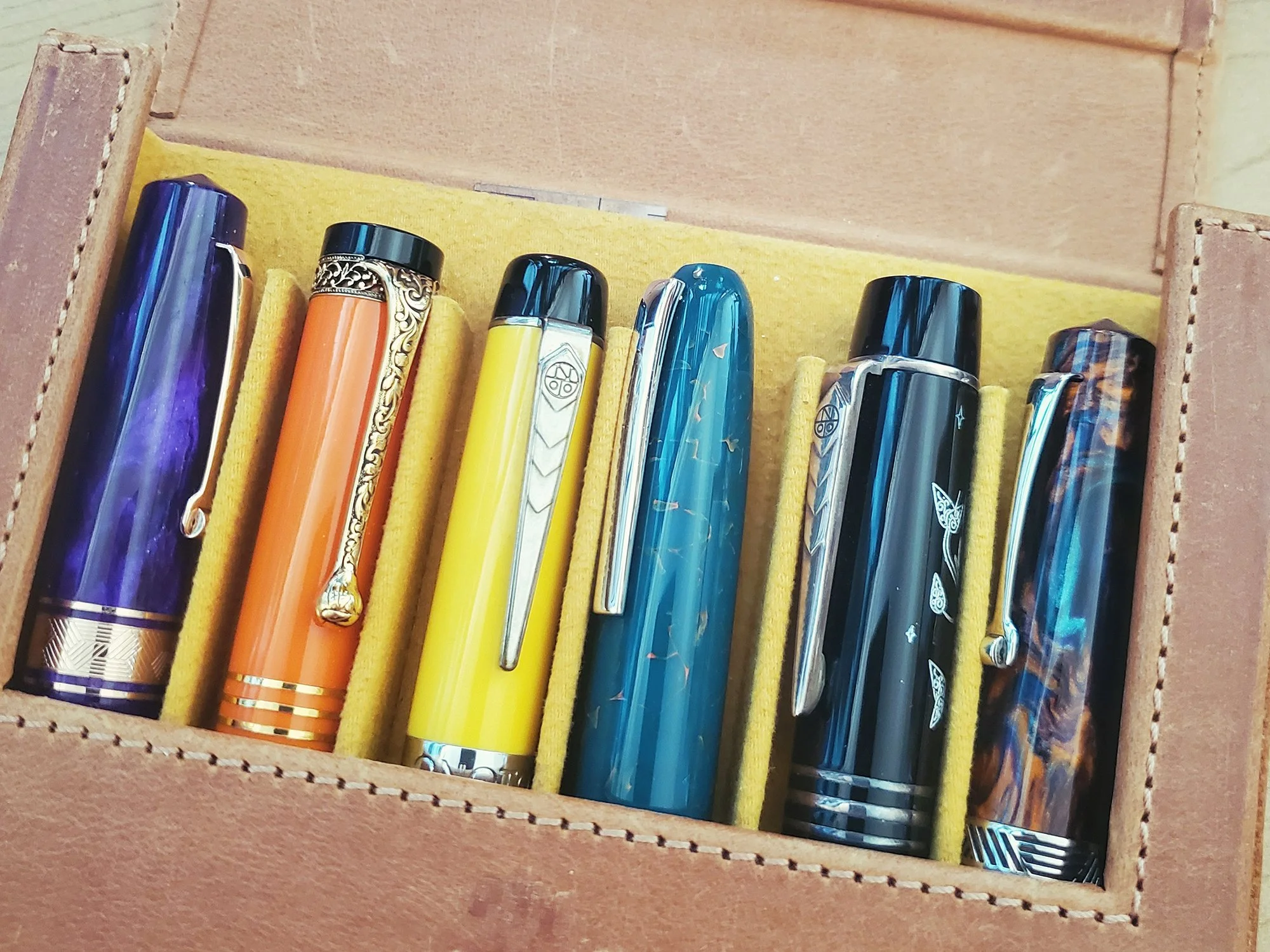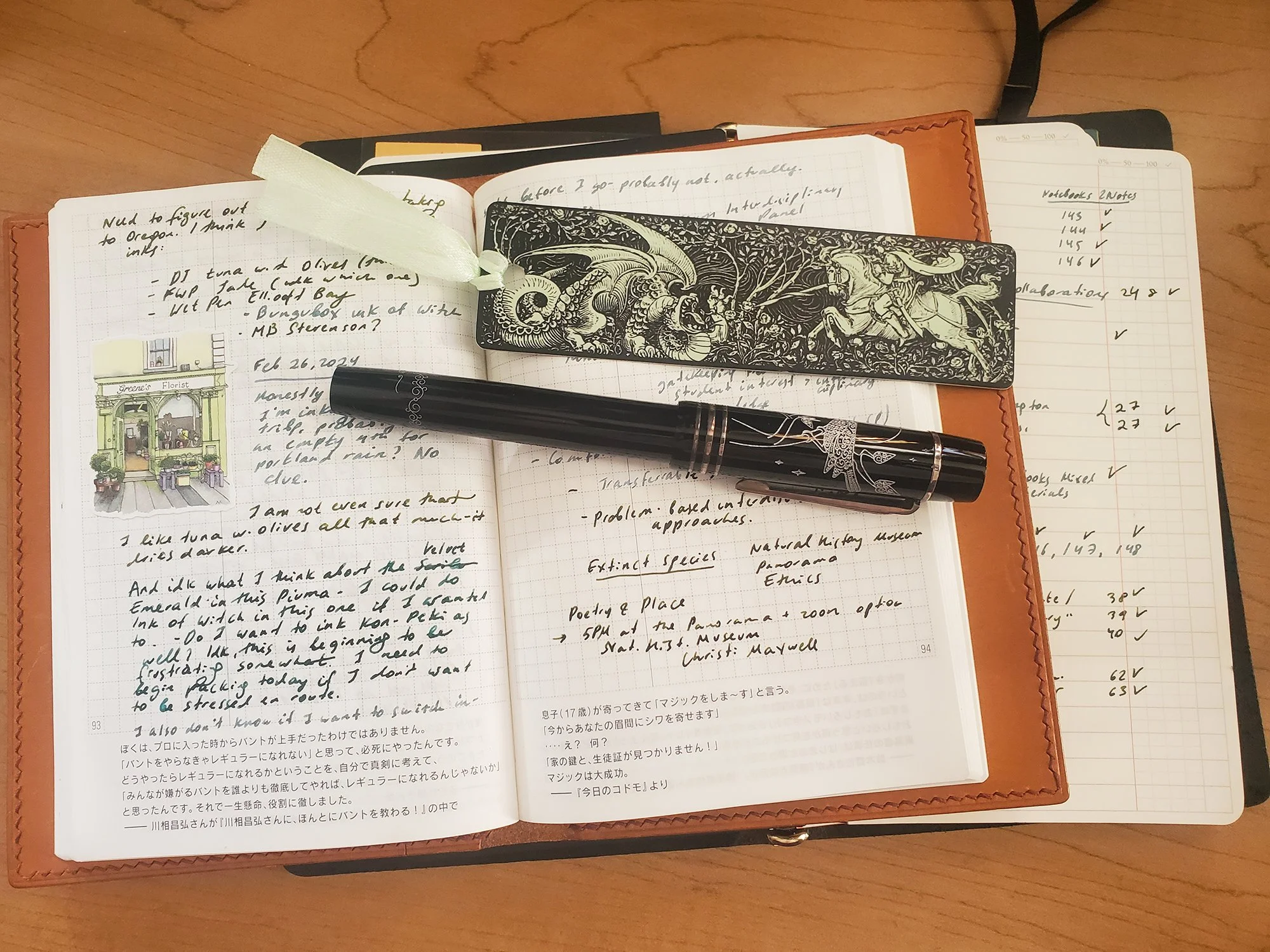A Portable Sanctuary
In 2021, when I was preparing to go to the University of Oregon for the first time, I spent an inordinate amount of time deciding which fountain pens to take with me. I’ve been waiting for a year to go on the trip - I was the winner of the 2020 Le Guin Feminist Fellowship, and we all know how 2020 shaped up. My 2020 was beyond traumatic - educating my disabled kid at home when none of his ADA accommodations were honored by the school system due to lockdowns, continuing my full-time job and academic leadership remotely, barely hanging on physically after injuring my back in a bad fall, managing a debut fiction launch two weeks after a tragic death of one of my closest friends, and the list kept rolling. UO Special Collections Archives was closed to external visitors for over a year. When I finally got a chance to go in 2021, I was still grieving, shaken, and bone-tired, and all I wanted to figure out was my pens. It seemed weird to me even in the moment, but I let myself fixate on the pens; some things are like that in my life. When I arrived to UO SCUA, I was predictably told that fountain pens were not allowed in the reading room. Only pencils.
The archivists gave me some pencils in UO SCUA.
I’ve been in so many archives before, how could I forget about this important detail? And yet.
It’s 2024, and I’m about to embark on my second trip to UO SCUA, working still on the same project, although it since spawned a few side projects. Here I am, sitting at my desk at home after a year of intense health issues and many, many, many other struggles which I am not going to recount here: in front of me are the pen candidates I am considering for my archival trip. I am not taking any pencils.
Writing postcards from Eugene back in 2021. Only one of these pens still remains in the gathering - the Sailor Pro Gear Après Ski.
Fountain pens are my emotional touchstone. I write with them, and they are also my stimming tools, and they are objects of beauty and delight, and they take interchangeable inks and sometimes interchangeable nibs so they’re always at least a little bit modular; they look different side by side when I select a few and ink them, yet they are harmonious together. When I leave home, even for a short while, the five or six fountain pens in their case become my portable sanctuary, a physical manifestation of respite, endeavor, and dream.
Currently inked from last week, in the Galen Leather Magnum Opus 6 case. The Aurora Internazionale does not leave home, but the other ones do.
I was a panelist at an interdisciplinary teaching panel at my university earlier this week, and as I sat down and arranged my pen case, Plotter, and A6 journal on the desk in front of me, I thought about how often I’ve been doing just that in the past few years: this simple act of setting down my tools. I am always taking notes and writing down ideas, but before I even begin taking notes, the weight of the pen case in my hand, and the well-worn look of leather signals, “I am here. I am in place. I am present.”
I’ve been thinking lately about how much I enjoy the sheer physicality of the pens. I have a smaller collection, so each one is very familiar to me through continuous use - not just the pen’s writing qualities, but also its sensory aspects - the color, shape, weight, and the tactile feel of the material. It’s difficult for me sometimes to be fully present in a face-to-face meeting after so many years of virtual meetings and an increasing fragmentation and even disappearance of our physical shared spaces. The weight of a pen in my hand and the feel of a smooth journal page helps me connect with the materiality and embodiment of meetings - the way people sit in a room, their names, the web of relationships which emerges from an especially good workshop or discussion.
Plotter and journal with daily notes; some about packing my pens, some about events I want to attend. Plotter notes are about the upcoming archival work. The fountain pen here is the Onoto Magna Keats.
Archival work is a much more solitary enterprise. In an old-fashioned archive, materiality is inherent in the very concept of “archival materials” - the weight, shape, handwriting or typewritten pages all provide a kind of sacredness which is amplified by solitude. Ironically, it is the later, digital part of this particular collection (such as emails or electronic files) which is less accessible to researchers right now.
Pens washed and drying in anticipation of being inked for the trip.
I am looking forward to my trip, even the many archival hours which I will spend penless. The pens will be waiting for me — my own portable sanctuary that connects me to my room, to my work, and to my dreaming. I will be writing with my beloved pens before and after.
Hope to see you from the road. :)





